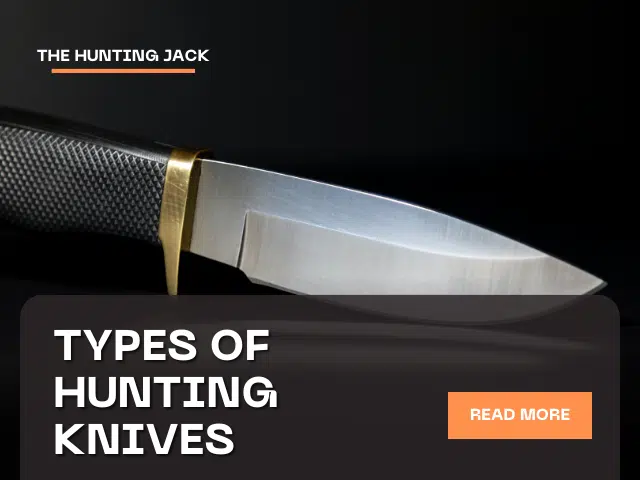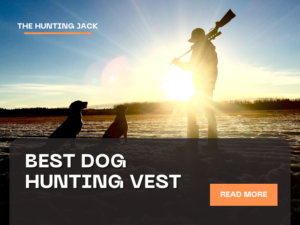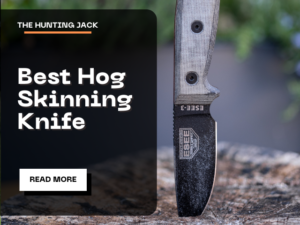There are quite a variety of hunting knives available for purchase today, so it can take time to determine which to buy and bring on your hunting trip. In this article, I’ll cover the different types of hunting knives available today. I’ll also offer a list of things you should consider when deciding on which knife to buy:
Table of Contents
ToggleThe Types of Knives For Hunting
Read on to follow along with my list of the different types of hunting knives:
Hunting Knives
At the top of our list, hunting knives are the primary type used for hunting. Unlike many other knives we’ll mention, these are specifically designed to kill.
Back in the day, humans primarily used hunting knives for hog hunting. These knives were usually long enough to get to the heart of an animal, such as a pig.
These knives have been redefined to mean knives exclusively used for game preparation, being used as a skinning knife, and for cutting up meat. However, in the past, hunting knives were supposed to be for the actual hunting of animals.
Bowie Knives
Speaking of large knives, I’d be remiss if I didn’t mention the infamous Bowie knife. Popularized by American soldier James Bowie, this fixed knife blade is suitable for hunting and is a great self-defense knife.
This knife boasts a long, wide blade with a clip point between six and twelve inches in length; it’s pretty intimidating. The clip point brings the blade’s tip lower than the spine for more control while attacking.
A Bowie knife also has a cross-guard, which keeps your hand from slipping off the handle and onto the blade.
Bowie knives are incredibly versatile and can be used for various functions because of their quality and size. While you can use it for traditional activities such as butchering or skinning, they’re even good enough (I wouldn’t explicitly recommend it because of the risk of damaging the blade) to cut down small trees.
Like hunting knives, this clip-point knife is a great all-around knife worth purchasing if you’re willing to invest.
Drop Point Knives
With thin, long knife blades, a drop-point knife is typically used to pierce game animals while keeping their skin and meat intact.
These hunting knives are designed with a spine that slopes down from their handle to the point. They also have a larger belly for slicing.
This blade shape is best for work involving detail and slicing; drop-point knives are generally associated with utility, and for a good reason. This all-purpose blade is perfect for both anticipated and unanticipated situations.
Skinning Knives
The purpose of the skinning knife is self-explanatory: these hunting knives were designed to be highly effective at skinning game animals.
With their thin blades and sharp rising head, a skinning knife will prevent the skin from tearing while cutting. They’re easy to control and boast a balanced feel, aided by non-slip handles that keep you from having a potentially painful accident.
And while primarily made for skinning, you’ll have little difficulty using a skinning knife for other tasks, such as gutting fish.
Gut Hook Knives
Like a skinning knife, gut hook knives have a particular purpose. This blade style is typically used for field dressing, as they have curved blades with sharp points. This helps to pierce the animal’s stomach, open it up, and remove the guts.
Best yet, gut hook knives help you easily remove the animal’s organs without causing any damage to them. Commonly used for fish, you can use these knives on various animals, including game animals such as large deer.
These knives are very efficient, letting you gut (although this depends on the animal’s size) in seconds.
Boning Knives
Another common and handy hunting knife is the boning knife; it’s designed for the sole purpose of helping separate meat from the animal’s bones. Boning knives generally have shorter, stiff, thick blades and are typically flexible.
These knives will typically be very sharp; a dull blade can cause damage to the meat rather than simply slicing it.
Boning knives, unless you’ve got a great “do-it-all” knife, are essential to any hunter’s kit. They help perform this vital task, effectively saving time and minimizing the risk of mistakes.
Buck Knives
Buck knives are a particular style of knives made popular by the brand Buck Knives. This knife is multipurpose and used for boning, cutting, and skinning.
These knives are almost always high-quality, and I’m a big fan. Buck Knives are quality-tested and often come as folding knives (they produce arguably the best folding hunting knife), which is also great for portability.
And while they were initially purely for hunters, these knives have now become multipurpose.
Special Mention: Camping Knives
They’re not a traditional hunting knife, but camping knives are still worth mentioning. Nowadays, they’ve been designed to perform many of the functions of a regular hunting knife.
Because of their design, camping knives also have a lot of utility for general tasks when camping. And like our other knives, most are made from high-quality steel, are thick enough not to break easily, and retain sharpness for a long time before becoming blunt.
I’d recommend camping knives for someone who isn’t hunting exclusively but may spend time outdoors occasionally.
When In Doubt: Hunting Knife Set
And if you need help deciding what to buy yourself, you’d do well to get yourself a hunting knife set.
These sets include everything that you’ll need on a hunting trip. While these will often come only as a set of three or so, some great 11-piece sets out there will help you with the entire game processing, from start to finish.
While some may think this is a bit much (I believe they might use the term “overkill”), these sets are great for the meticulous few who want to ensure they do a great job preparing their game meat.
Hunting Knives: Optional Features
A hunting knife may come with several optional features. You may or may not need these depending on your particular requirements:
Serrated Blades
While this is uncommon, sometimes a hunting knife may come serrated. You may also know these blades as “toothed” or “dentated.” Whatever you know them as, while they can be helpful in some instances, they can make things more difficult in certain situations, such as when field dressing.
Hand Guards
Hand guards keep your hand in place while skinning or butchering game. And any hunter who’s done this enough knows just how messy this can get. Trust me; you should be happy if your knife comes with a hand guard, as this can save a lot of trouble.
Gut Hooks
Some hunting knives come with gut hooks (like we discussed earlier) that are used by hunters specifically for field dressing. The semi-circle in the spine helps hunters “unzip” animal skin to clean it out.
While gut hooks make the process easier, most fixed-blade knives can already gut an animal without too much difficulty.
Better Handle Types
Sometimes a hunting knife may come with improved handles that make the use of the blade an easier or more comfortable experience:
Non-Slip
These types of handles are essential for some knives, such as skinning knives, as they help prevent disasters. If your hand slips, you could risk damaging the meat or even yourself; stitches aren’t cheap.
Ergonomic
Ergonomic handles make the overall experience of using a hunting knife much more pleasant. Knives may have a swell in the middle of the handle that makes contact with your palm, and some may even have gentle curves at the back and front of the handle.
Sheaths
A sheath is such an essential part of a hunter’s kit that it’s almost always included with any new hunting knife. Carrying a knife around becomes a tricky (and somewhat dangerous) affair without a sheath.
Most knife sheaths are made of leather: this won’t scratch your blade and is flexible enough not to cause structural damage to your blade.
When Buying a Hunting Knife, Consider This:
When buying a hunting knife, it’s essential to look at several crucial factors that influence the suitability of any blade. In the following paragraphs, I’m going to detail exactly what it is that you should be looking at:
Reliability
This is an essential factor to consider when purchasing a hunting knife. Ideally, you’d want something that’ll last a very long time unless you don’t plan to hunt very often.
You also want something that won’t break while you use it or dull out quickly.
Effectiveness
The effectiveness of a blade should always be considered when contemplating purchasing a hunting knife. A blade that isn’t very sharp or not suitable for what you require it to do is just not worth buying.
Versatility
Particularly with hunting knives, most of us want one that can do various things, such as cutting out the skin, field dressing, and other generic things. Getting a knife that is made particularly to skin means that it’s not very versatile and cannot be considered a traditional hunting knife.
Features
Many knives have different features, such as non-slip handles or high-quality sheaths. These are significant factors in determining whether to purchase a particular knife or not. Hunters prefer knives with tons of great featuresrs.
Cost
Last but certainly not least, there is the cost. While many of us may not think spending much money on a hunting knife is a good decision, having a high-quality knife can make a huge difference. Spending a little bit more for something much better is always a good idea.
Who are Hunting Knives For?
A hunting knife is for anyone likely to find themselves in a situation where they must hunt, skin, and butcher meat. This could be on a hunting trip or just for general survival purposes.
FAQs
What are large hunting knives called?
A common and popular large fixed-blade knife is the Bowie knife. These fixed-blade knives boast a raised tip and are great for gutting game animals and general self-defense while hunting.
What knife is used for skinning?
The best skinning knife is the aptly-named skinner knife. Unlike other hunting knives, these typically have a thin, curved, and wide blade that helps you cut through the skin without damaging the meat; you can buy one as a folding knife or fixed blade.
What is the best knife to field dress a deer?
The best knife to effectively field dress a deer is one with a grip that is not slippery and a sharp blade. When people think of gutting deer, many might think of Buck Knives, particularly the Buck 110. You might also want to try a clip-point blade, such as a Bowie knife, but these may not be the most effective.
How many types of hunting knives are there?
Many types of knives may be considered hunting knives; for example, a skinner knife is considered a hunting knife, but just for cutting the skin. There is also a drop-point knife, gutting, and boning knife. Finally, there’s the Bowie knife and the multipurpose Buck knife.
Bigger Isn’t Always Better
When deciding on the right hunting knife for you, bigger isn’t always better. The primary concern is the usability it has for various hunting tasks. For example, a gut hook knife is right for you if you’re looking for something primarily for gutting. If you need something more all-around useful, a traditional folding knife for hunting would be best for you.



